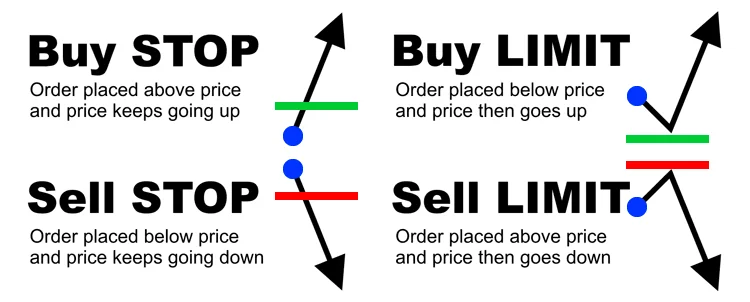Pending orders are instructions you give to your broker to execute a trade at a specific price level in the future. They allow you to set up trades even when you’re not actively monitoring the market.
The term “pending orders” in Forex trading refers to orders that are pending or waiting to be executed in the future once certain conditions are met. They are called “pending” because they have not yet been filled or activated in the market at the time they are placed.
When a trader sets up a pending order, they specify certain conditions such as a specific price level or a particular market situation that needs to occur for the order to be triggered. Until these conditions are met, the order remains pending, waiting in the broker’s system or platform.
For instance, a trader might place a pending order to buy a currency pair if the price reaches a certain level higher than the current market price. Until the market reaches that specified price level, the buy order remains pending. Once the market reaches or surpasses that price, the pending order becomes active and is executed as a market order.

When dealing with pending orders, there are a few key factors to consider :
Market Analysis: Before placing any pending orders, it is crucial to perform a thorough analysis of the market. This includes studying price charts, identifying support and resistance levels, and analyzing key technical indicators. By understanding the market context, traders can make more informed decisions about where to place their pending orders.
Order Placement: When placing pending orders, it is essential to select appropriate entry and exit points. Traders should consider factors such as recent price movements, volatility, and the overall trend of the market. Placing orders too close to current market prices may result in frequent stop-outs, while placing them too far away may decrease the risk-reward ratio.
Risk Management: Just like any other trading strategy, risk management is crucial when using pending orders. Traders should determine their risk tolerance and set appropriate stop-loss and take-profit levels for each trade.
© 2015-2023 PipupFX. All Rights Reserved.
HIGH RISK WARNING: Foreign exchange trading carries a high level of risk that may not be suitable for all investors. Leverage creates additional risk and loss exposure. Before you decide to trade foreign exchange, carefully consider your investment objectives, experience level, and risk tolerance. You could lose some or all of your initial investment. Do not invest money that you cannot afford to lose. Educate yourself on the risks associated with foreign exchange trading, and seek advice from an independent financial or tax advisor if you have any questions. Any data and information is provided ‘as is’ solely for informational purposes, and is not intended for trading purposes or advice. Past performance is not indicative of future results.